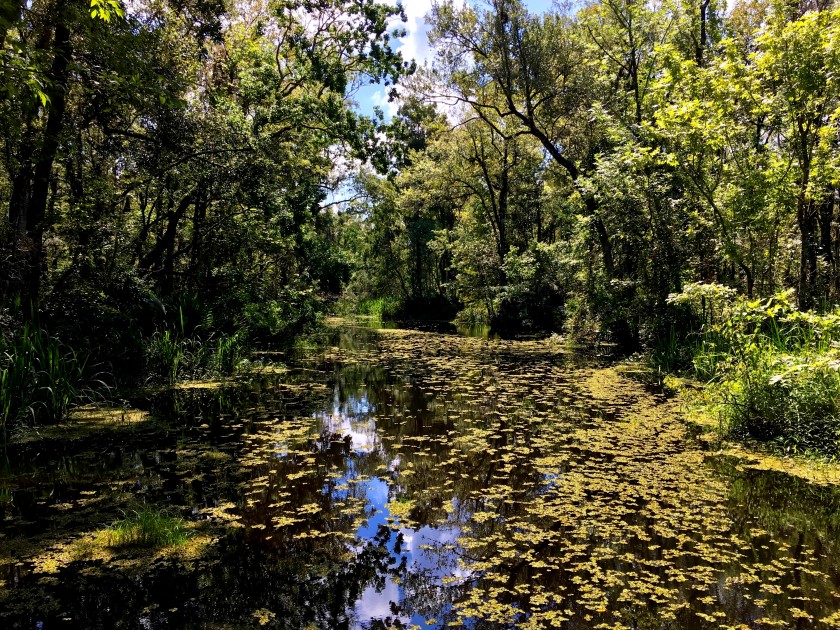SOURCE: Los Angeles Times
DATE: November 29, 2020
SNIP: Hidden away in the heart of the Deep South, one of the nation’s greatest wildernesses is being destroyed, bit by bit, in a silent massacre.
You won’t find people chaining themselves to trees to protect this place, or national environmental groups using pictures of it to sign up new members, because few know it exists. And yet, here it is — the Mobile River Basin, one of the richest in the world in terms of the sheer number of species and types of habitat. The major rivers and thousands of creeks feeding into this basin together form the largest inland delta system in the United States, second only to the Mississippi in how much water it dumps into the Gulf of Mexico.
The river system, the fourth-largest in the country in terms of water flow, stretches from the northern edge of Alabama to the Gulf, draining parts of four states, and encompassing hundreds of thousands of acres of forest, from Appalachian hardwood stands to haunted cypress swamps. A dedicated band of locals know it for the incredible hunting and fishing it affords. But few know it for its greatest distinction. That’s a shame, for this is America’s Amazon, far and away the most biodiverse river network in North America.
There are more species of oaks on a single hillside on the banks of the Alabama River than you can find anywhere else in the world. The Mobile River Basin makes Alabama home to more species of freshwater fish, mussels, snails, turtles and crawfish than any other state. The contest isn’t even close.
For instance, Alabama is home to 97 crawfish species, while California, three times the size of Alabama, has but nine. There are 450 species of freshwater fish in the state, or about one-third of all species known in the entire nation. The system’s turtle population is even more singular. The Mobile-Tensaw Delta estuary system has 18 turtle species, more than any other river delta system in the world — more than the Amazon and more than the Mekong, both extraordinarily biodiverse ecosystems.
Unlike most of the nation’s great river systems, the Mobile Basin — along with its wetlands, floodplain forests and estuary — has survived with its biological community mostly intact. That is due in large measure to an odd combination of benign neglect and the mixed blessing of being located in the heart of Alabama. Tragically, it now sits on the cusp of decline, facing death by a thousand cuts, just as the scientific community has begun to appreciate its riches. Habitat destruction, development and lax enforcement of environmental regulations conspire to take an increasing toll, making the area a global hot spot for extinctions, particularly of aquatic creatures.
In fact, nearly half of all extinctions in the continental United States since the 1800s have occurred among creatures that lived in the Mobile River Basin, according to records maintained by Endangered Species International and the U.S. Fish and Wildlife Service.
Alabama’s wild places have long benefited from a predominantly rural economy and sparse development, as the state missed out on the great industrial and technological growth spurts seen elsewhere in the nation since the 1950s.
But today, Alabama is poised for a period of prodigious expansion. Thanks to hefty tax credits, business-friendly labor laws and lax environmental regulation, the state has become a manufacturing hub, with Mercedes, Hyundai and Honda all making cars at new assembly plants. An Australian company now builds battleships for the Pentagon in Alabama, and Airbus began assembling several of its jetliners on the shores of Mobile Bay in 2015.
Subdivisions and cities are spreading quickly across acreage long devoted to timber, agriculture or kudzu. With that growth comes the likelihood of accelerated destruction for what scientists have only begun to realize is one of the most diverse ecological areas outside of the Amazonian rain forests.
The decline is already beginning to show. Mobile Bay, the catch basin for this river system, now has annual dead zones, like the well-publicized ones in the Gulf of Mexico, due to excess nitrogen and other nutrients flowing from fertilization of farms and suburban lawns.
Meanwhile, the rivers of the Mobile basin have been dammed and channelized and bear the scars of industrial pollution, with swamps that rank among the most polluted in the nation for DDT, mercury and other contaminants. Our rivers are now often a muddy brown, a testament to the amount of runoff coming from farms, urban areas and subdivision construction sites.
The fall of 2016 proved just how precarious things have become, as numerous rivers in the basin and streams ran completely dry, in some cases for the first time ever. While this happened during a short drought, the real causes were the various industries — paper mills, coal mines, steel mills, golf courses — that in the absence of government oversight or regulation were allowed to suck up the last drops from the rivers.
Despite having more miles of rivers and creeks than any other state, Alabama has no official rules governing the amount of water that industries may draw from them. Instead, companies along riverbanks are guaranteed rights to the water no matter what environmental havoc may occur.
We can already witness the effects of these governmental failures on Alabama’s incredible natural heritage. The rate of aquatic and terrestrial species extinctions in Alabama is roughly double that seen anywhere else in the continental United States.
Alabama has lost 90 species, followed by California at 53 species. On top of the 90 species confirmed as extinct in Alabama, scientists think an additional 90 species may have slipped into extinction, and the U.S. Fish and Wildlife Service suggests that another 100 species should be protected under the Endangered Species Act.

